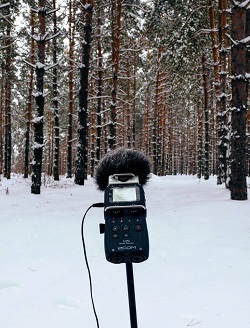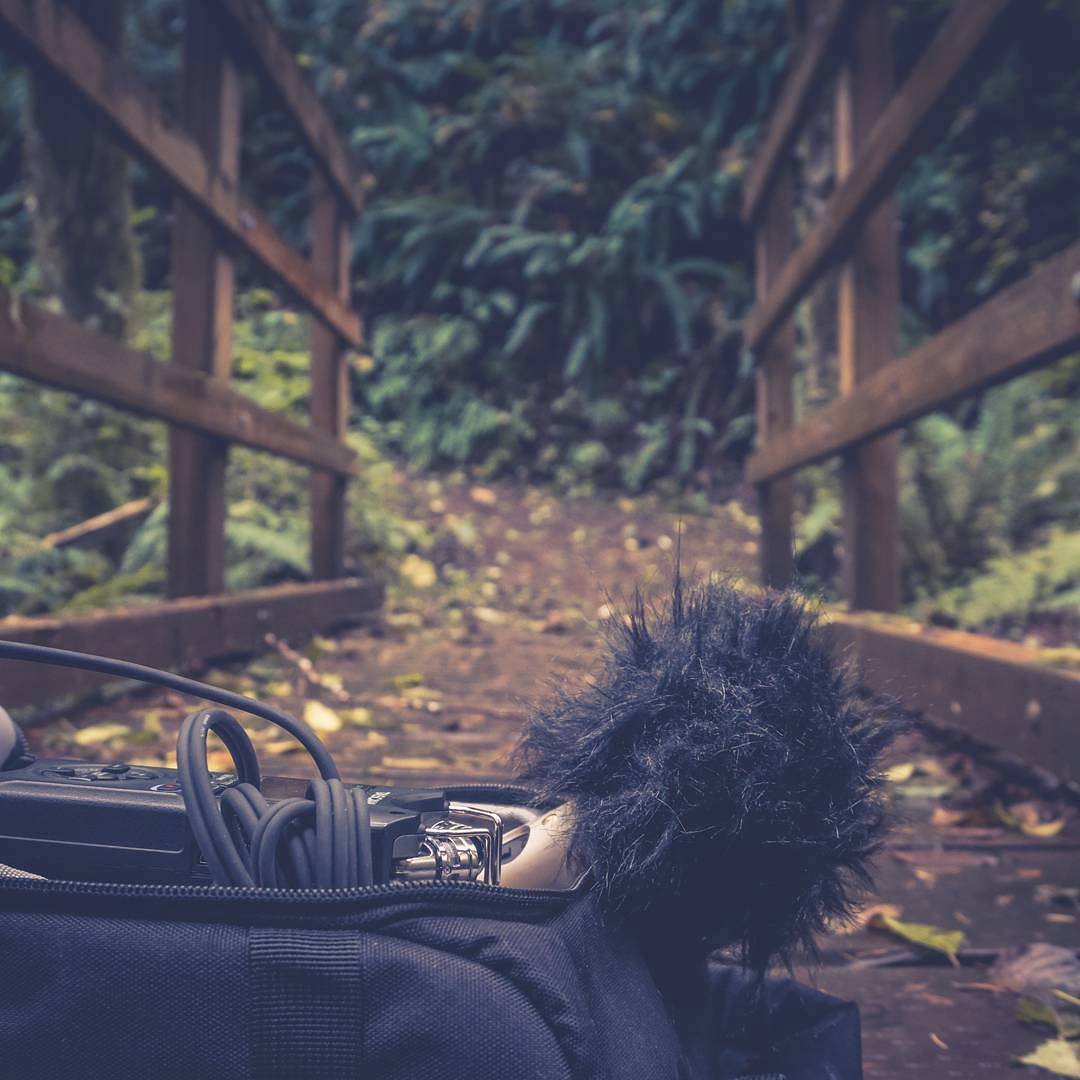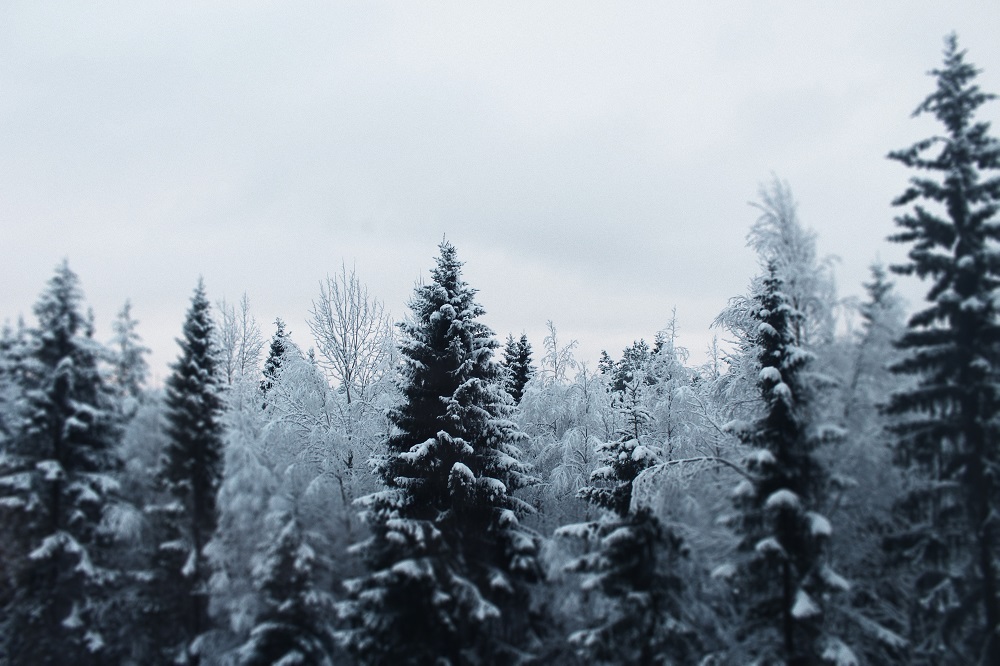3. Field Recordings
a. How important are field recordings to dark ambient music?
protoU: Field recordings are the essence of the realistic atmosphere we want to convey in dark ambient. Its purpose is to be immersive and get to the point where the listener is fully in the place and time, which the musician is trying to show.
Aegri Somnia: Alot in my music, i like organic/nature feel to high frequency spectrum, sound gets another dimension with field recordings.
Stuzha: To me, FR are always number one. You can make so much from just using FR alone and post-processing. By the way there are amazing FR banks around, like this one https://www.soundsnap.com/

Stuzha, gathering field recordings.
Seesar: I do use field recordings, including ambient sound, sampling, and ethnomusicology field recordings, where applicable and ethically acceptable. Examples of field recordings I have used in my works include cat meowing, raven songs, rain and wind, construction machinery, brad machines, vacuum cleaners, drills, high school pep rallies, and music recorded during ethnomusicology fieldwork research trips (used with permission). The importance of their use is a matter of taste and style. Field recordings certainly add a particular flavour to a piece that cannot be gained otherwise, but it also places a piece in a specific mentality framed by the field recording, which must also be considered by the composer. There is nothing negative about using field recordings, just to be clear. However, they can change the aesthetic of a piece. Their importance is strictly determined by the value the composer places on them.
Skadi: As explained before regarding drones, field recordings are quite important to dark ambient music but not required. There are many dark ambient tracks around without any field recording usage. E.g. I rarely use field recordings in my tracks. They can definitely provide a very distinctive mood in a track, but emotions and moods can also be transfered with other methods and approaches to dark ambient.
Mebitek: Should be the key point for originality.
Shrine: Most ambient artists use them I think, more or less. Perhaps, it depends on the specific music. For the so called “organic ambient”, for example, all the natural sounds are an integral part of the music.
Sonologyst: They are another fundamental component in dark ambient music. They are the ingredient to create visual atmospheres, vivid landscapes, even stories. They forge a solid concept when the musician has something interesting to tell through the music.
Ugasanie: Everyone decides for themselves. Personally, I use them all the time. I love ambient with field recordings. They create the right atmosphere, for me.
b. What electronics do you use to capture field recordings?
Stuzha: I always had Zoom recorders. Now it is Zoom H4. I managed to freeze it a few times, but otherwise it is a solid piece of equipment.
Atrium Carceri: Tascam DR-100 with a dual XLR connected Röde NT4.

Atrium Carceri, field recording expedition.
Shrine: I used to have a portable field recorder. I sold it off a few years ago, as I wasn’t satisfied with its sound quality. I never bought a new one though. Nowadays it’s easy to find high quality samples online and I already have a pretty big sound library with my own field recordings too.
Aegri Somnia: My phone for recent recordings. Any cheap Tascam/Zoom/Sony stand-alone recorder will do the job.
Seesar: I use either a portable M-Audio digital recorder or I set up my laptop and capture field recordings with my M-Audio soundcard and Röde NT-4 point stereo mic.
Skadi: Since I don’t field record on my own, I use specific libraries with field recordings if required for my tracks.
Mebitek: Zoom H1
protoU: I use voice recording software on my iPhone. It is more than enough for me for now, but I’m sure I’ll get a good mic someday. I also have a friend with a recording studio, where I borrow different microphones to record stuff.
Sonologyst: I’m not a professional of field recordings, so I use simply an iPhone when I’m around to catch everything that could be interesting.
Ugasanie: Tascam DR05
c. Do you use a wind-screen?
Aegri Somnia: No
Stuzha: I like these… furry things 🙂
Seesar: Yes. All of my devices have their own, purpose-made, foam windscreen. I also, occasionally, use a floating pop screen for loud or aspirated sounds.
Atrox Pestis: Always if I am outdoors – even if it is just my t-shirt wrapped around the mic. I have different wind screens for different mics, but I generally use an open cell foam screen that fits a compact omni mic, which I use most frequently.
Mebitek: Yes, a zoom h1 ball wind screen.
protoU: No, I don’t.
d. What kind of wind-screen?
Atrium Carceri: Dead Kitten
Shrine: Foam and fur. Two for the built-in mics of the portable recorder, and one more for the external stereo mic I was also using back then.
e. When is it necessary to use a wind-screen?
Stuzha: Depends on what you record, of course. But you can’t go wrong keeping it on your mic all the time.
Seesar: In my opinion, always. Perhaps, if a sound is extremely faint and there is no chance of wind contaminating the recording. But even then, I would more likely tend to use the windscreen, just to be safe. At first, I never used a windscreen of any description. I found myself continually editing out pops, clicks, clipping, and distant unwanted sounds. Using a windscreen helps reduce a lot of post-recording editing issues. I admit, I pay particular detail to using as clean of a sample as possible, so perhaps I address these issues with far too much attention. However, in my experience and using my approaches to field recording, I cannot recommend using a windscreen enough.
Mebitek: I always use one, because it gets cleaner sounds.
Shrine: All the time, I guess, when recording outdoors. The chances to get the perfect conditions when the windscreen won’t be needed are tiny. But I guess this is more true for recording quiet sounds (e.g. nature) than loud sounds (e.g. machines).
f. Do you leave the field recordings raw or do you add effects treatment to them?
Treha Sektori: I do treat them. Sometimes, I can record for an hour and only find a couple of seconds that, after modeling, I get what I feel.
Kammarheit: I rarely use raw field recordings. I have been using a Zoom H4n for many years and it has been enough for the type of music I want to make. I am not very interested in adding footsteps, dripping water or other easily recognisable sounds. But I really like the process of collecting sounds, that I then manipulate. High and long metallic sounds or traffic recorded through tunnels or under bridges. I often layer lots of different field recordings on top of each other, and play the whole mix as one instrument on my keyboard, making long, meditative drones. As long as it doesn’t get too muddy.

Pär Boström (Kammarheit), view from the studio.
Aegri Somnia: Raw, I just cut unnecessary frequencies. When I use an unusual sound, then I manupulate it and use it for a specific purpose.
Stuzha: I like both. Sometimes it is important to tell the story, so I use raw.
Seesar: It depends on the sound recorded. I would say, typically, I remove noise and unwanted sounds from a field recording. Then, I edit it to use the section I want, and often add some effect (reverb, change of pitch, echo, et cetera), along with a raw version whenever feasible. This ensures the original recording is heard, but within the context of the dark ambient piece, alongside the altered version of the recording.
Atrium Carceri: Almost always EQ, and most times compression to smooth volume spikes, if too rough.
Atrox Pestis: Both. I want some sounds to be very clear as to their source. Others, I may have recorded because I wanted to capture a texture or specific tone, and then I’ll add the effects that will boost what I like about the recordings or alter them altogether.
protoU: I usually put some effects there. It depends on if I want to convey the very realistic atmosphere (that the field recording is about: forest, rain, swamp, night-time, church etc.), or I want to play with it and make it, turn it to something completely opposite adding some delay, distortion (example: when I have a sound of a frying egg and try to turn it into the sound of a burning flame.)
Shrine: Essentially every sound in music production needs treatment (as equalization, compression, etc.), not only field recordings. Yes, sometimes it is possible to have a perfect raw sound that you can use without any treatment but this is rather an exception. And if by treatment you mean adding sound effects like reverberation or distortion, then it depends on the specific composition and how you want it to sound, so it’s up to you.
Sonologyst: I usually treat field recordings with additional reverbs. But the most important thing is to find the right level for the field recording layer in the mix. Mixing is by all means a crucial part in the process.
g. Do you use field recordings in the creation of drone or do you only use them as a secondary layer of sound?
Aegri Somnia: I use them as layers only.
Stuzha: Yes, some field recordings can be perfect for the drone manufacturing process.
Seesar: Both. If a field recording is long and droning, then, obviously, it is most likely suitable for being a drone within a piece. I also may take a shorter sample and stretch it to make it a drone, or vice versa, edit a long recording to use it for secondary layer sampling. Shorter sounds, though, tend to be used more clearly on top of drones in my pieces.
Skadi: If I use field recordings, I usually use them as a secondary layer with heavy treatment.
Mebitek: I usually use them as a second layer, but sometimes I use them as a sound generator.
protoU: Sometimes field recordings are the basis of drones, because the natural atmosphere often has it’s own natural sounds, even with notes sometimes.
Shrine: No, my drones are always synthesized. Field recordings are mostly used as a background.
Sonologyst: It’s possible to use field recordings for drones, why not?

